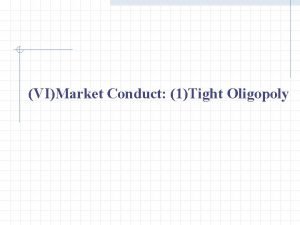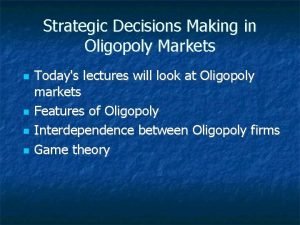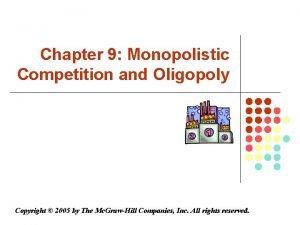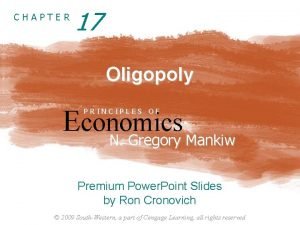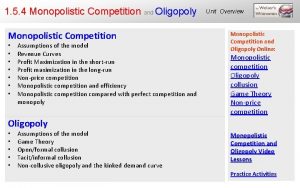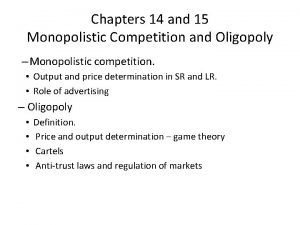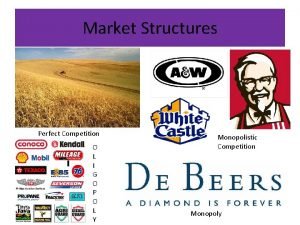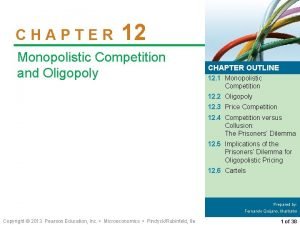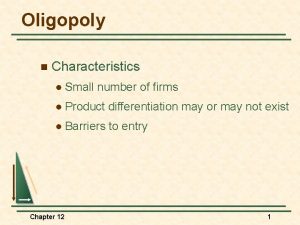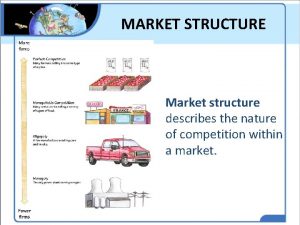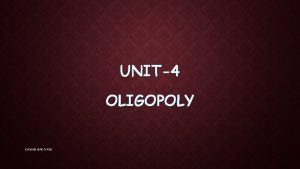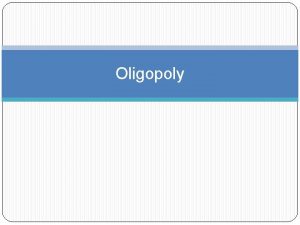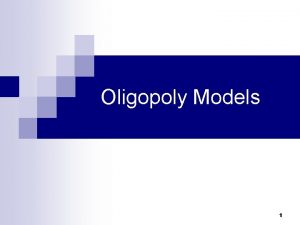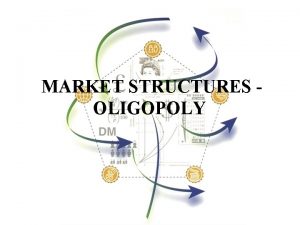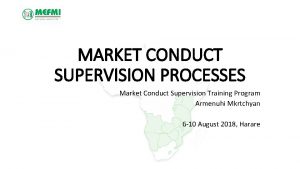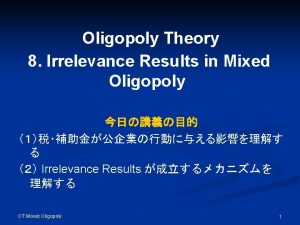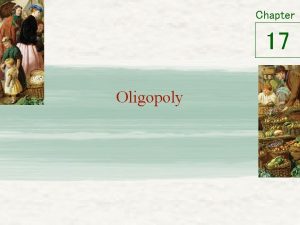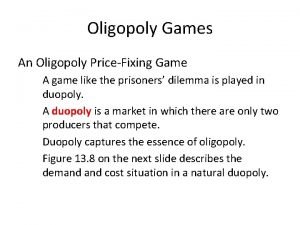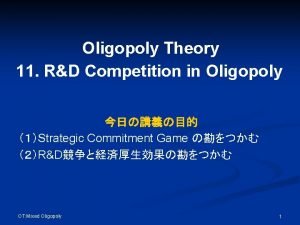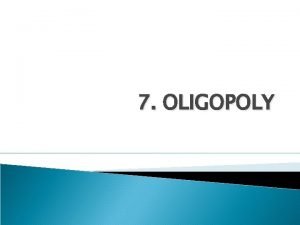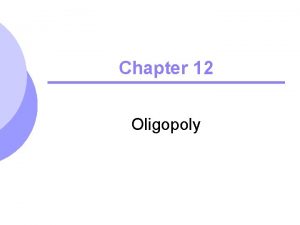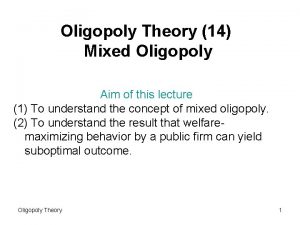VIMarket Conduct 1Tight Oligopoly 1 VI Market Conduct























- Slides: 23

(VI)Market Conduct: (1)Tight Oligopoly 1

(VI) Market Conduct: (1)Tight Oligopoly ● CATEGORIES OF MARKETS (10) Ineffective Competition: Effective Competition: Competition 1. Monopoly 1. Loose Oligopoly 2. The Dominant Firm 2. Monopolistic Competition 3. Tight Oligopoly 3. Pure Competition 2

● STRUCTURE , BEHAVIOR AND PERFORMANCE 3

4

(VI)Market Conduct: (1) Tight Oligopoly ● BASIC CONCEPTS 1. The Main Lines of the Topic : i. Oligopoly is about fewness and interdependence. ii. Oligopoly also means a wide range of outcomes. iii. There is indeterminancy. iv. Strategy is required. v. The oligopolists always have mixed, conflicting incentives between competing and colluding. 5

2. Conflicting Incentives: Cooperation vs. Cheating Even if it dosen’t go as far as point X, it gains by every extra unit it sells. 3. Most of the results of oligopoly merely confirm larger, intuitively obvious truths, but the analysis satisfies the urge of theorists to prove something. 4. Oligopoly remained stubbornly unsolved , except in abstract specialized blackboard games. 6

7

● BASIC THEORIES OF INTERDEPENDENCE 1. Models of Non-collusive Duopoly models have always ignored direct collusion. Instead they look only at indirect non-collusive behavior. ◎The ◎ The assumptions are extremely narrow. — The latest game theory excitement has faded. i. Game Theory: Using Payoff Matrixes to Illustrate Duopoly Choices The game theory models have three severe weakness: (1). They are short run. (2). They assume that each firm is myopic. (3). They assume that firms never think about doing any directly collusive actions. 8

● BASIC THEORIES OF INTERDEPENDENCE 1. Models of Non-collusive Duopoly i. Game Theory: 9

● BASIC THEORIES OF INTERDEPENDENCE Colin’s Actions Confess Don’t Confess Colin gets 20 years Confess Rose’s Actions Don’t Confess Rose gets 20 years Colin gets 30 years Rose gets 3 years Colin gets 3 years Rose gets 30 years Colin gets 5 years Rose gets 5 years 10

● BASIC THEORIES OF INTERDEPENDENCE Gus’s Actions Low Price High Price Gus’s profit = $25, 000 Gus’s profit = –$10, 000 Low Price Filip’s Profit = $25, 000 $75, 000 Filip’s Actions Gus’s profit = $75, 000 = $50, 000 High Price Filip’s Profit = $– 10, 000 Filip’s Profit = $50, 000 11

● BASIC THEORIES OF INTERDEPENDENCE 1. Models of Non-collusive Duopoly i. Game Theory: 12

ii. Cournot Output-Setting Models (1838): independent, passive, myopic 13

14

Cournot Model: As the number of (equal size) firms rises to N, the optimal output of each firm of the N firms when equilibrium is reached 1/ (N+1) x OQ [ 1 - (N-1)/(N+1) x OQ = 2/(N+1) x OQ ] 15

iii. Bertrand Price-Setting Duopolists (1880) It involves the possibility of product differentiation. 16

2. Kinked Demand Curve: Sweezy (1939) 1. Timid Attitudes 2. Aggressive Attitudes 17

● CARTEL, TACIT COLLUSION AND PRICE LEADERSHIP 1. Cartel 2. Tacit Collusion Tacit (implicit) collusion requires that the oligopolists build up a degree of shared knowledge and trust. i. Concentration ii. Homogeneity iii. Stable Industry Conditions iv. Familiarity etc. 18

3. Price Leadership 19

● TYPES OF COLLUSION 1. Cartels 2. Controls 3. Agreements 4. Tacit Collusion 5. Other Devices 20

● CONDITIONS FAVORING OR DISFAVORING COLLUSION 1. Number and Size Distribution of Sellers-Concentration 2. Product Differentiation. 3. Costs 4. Demand 5. Lumpiness and Infrequency of Orders 6. Information 21

● CONDITIONS FAVORING OR DISFAVORING COLLUSION 6. Similarity of the Firms’ Conditions 7. Familiarity Over Time ( The Social Scene ) 8. Secrecy and Retaliation Lag 9. Rule-of-Thumb Pricing 10. Focal Points (Tacit Coordination) 22

23
 Vimarket
Vimarket Vimarket
Vimarket Example of oligopoly market structure
Example of oligopoly market structure Example of oligopoly market structure
Example of oligopoly market structure Market leader follower challenger nicher
Market leader follower challenger nicher Segmentation target market and positioning
Segmentation target market and positioning Market conduct supervision
Market conduct supervision Market conduct examiners handbook
Market conduct examiners handbook Structure-conduct-performance
Structure-conduct-performance Advantage of monopolistic competition
Advantage of monopolistic competition Oligopoly board game
Oligopoly board game Chapter 17 oligopoly
Chapter 17 oligopoly Current price
Current price Oligopoly demand curve
Oligopoly demand curve Examples of oligopoly competition
Examples of oligopoly competition Oligopoly
Oligopoly Chapter 7 section 3 monopolistic competition and oligopoly
Chapter 7 section 3 monopolistic competition and oligopoly Monopoly vs oligopoly venn diagram
Monopoly vs oligopoly venn diagram Oligopoly questions
Oligopoly questions Pure competition advertising
Pure competition advertising Conclusion of oligopoly
Conclusion of oligopoly Oligopoly model
Oligopoly model Barriers to entry oligopoly
Barriers to entry oligopoly Pros and cons of oligopoly
Pros and cons of oligopoly
